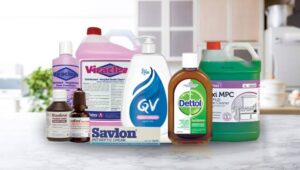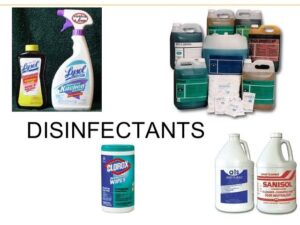Back to: MICROBIOLOGY 100 LEVEL
Welcome to class!
It’s always great to have you back. Every time you sit to learn, you’re investing in a brighter future—for yourself and for others who will benefit from your knowledge. Today, we’re talking about something you probably see every day but may not fully understand yet—disinfectants and antiseptics. These two might seem similar, but they have very different roles in protecting us from harmful microbes.
Disinfectants And Antiseptics
Let’s imagine this: You accidentally cut your finger while peeling yam. Your mum quickly reaches for a bottle of antiseptic to clean the wound. But earlier that morning, she used a different chemical to mop the kitchen floor and wipe down the bathroom sink. That second chemical was a disinfectant. Both products are used to kill germs—but one is used on your skin, and the other on hard surfaces.

So, what exactly are disinfectants and antiseptics? Let’s understand them clearly.
Disinfectants
Disinfectants are chemical agents used to destroy or reduce the number of harmful microorganisms on non-living surfaces such as floors, toilets, hospital equipment, tables, and walls.
They are usually too strong to be used on the skin or body because they can cause irritation or even burns.
Examples of disinfectants:
Sodium hypochlorite (bleach) – Commonly used in homes and hospitals for mopping floors or cleaning toilets.
Phenol – Used in labs and industrial settings.
Chlorhexidine (in high concentration) – For disinfecting hospital tools.
Alcohol (above 70%) – Sometimes used to clean surfaces like thermometers or lab benches.
Disinfectants don’t always kill all microbes (especially spores), but they drastically reduce the number, making surfaces safer.
Antiseptics
Antiseptics are chemical substances used to destroy or inhibit the growth of microorganisms on living tissues like skin, wounds, or mucous membranes.
They are milder than disinfectants so that they don’t damage human tissue.
Examples of antiseptics:
Dettol (chloroxylenol) – Common in many Nigerian homes for treating small cuts and wounds.
Savlon – Another popular antiseptic liquid.
Hydrogen peroxide – Often used for cleaning wounds.
Iodine or povidone-iodine – Used before surgery to clean the skin.

Alcohol (about 60–70%) – Used as hand sanitisers or skin wipes before injections.
Antiseptics are essential in first aid and clinical care to prevent infections.
Summary
- Disinfectants are used on non-living surfaces to kill or reduce harmful microbes.
- Antiseptics are used on living tissues like the skin or wounds.
- Disinfectants are usually stronger and not safe for skin, while antiseptics are milder and safe for human use.
- Common disinfectants include bleach and phenol; common antiseptics include Dettol and iodine.
- Both are important for infection control in homes, hospitals, and public places.
Evaluation
- What is the main difference between disinfectants and antiseptics?
- Give two examples each of disinfectants and antiseptics.
- Why is bleach not safe to use on the skin?
You’re learning the kind of knowledge that keeps people safe and healthy, and that’s powerful. Your hard work is not going unnoticed. Keep going—Afrilearn is cheering you on every step of the way. The next lesson is waiting for you, and it’s going to be just as exciting. Let’s keep learning together together!
